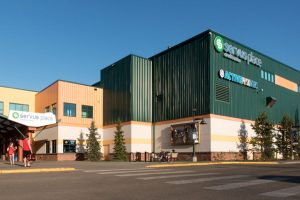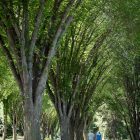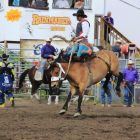Then & Now
ST. ALBERT’S MULTIPLEXES
May, 2016
St. Albert has many top-notch sports facilities that attract -people from all over the region. But it hasn’t always been that way. There was a time, not so long ago, when St. Albert’s athletes had to wait for Mother Nature’s permission before they could play their sports. Hockey was purely a winter affair, and if you wanted to swim, you’d have to wait for those hot summer days to make a pool out of your skating rink. It’s been a long road, but thanks to our sports complexes, those days are now behind us.

1970s
In the early days of St. Albert, seasonal outdoor facilities were all that were needed to support the needs of the small community. But in the late 1960s, the town’s population started booming, and city council decided that proper facilities were needed to meet the recreational desires of the growing population. And so, in 1971, the town’s first indoor ice rink was built on the corner of St. Thomas and Perron Street, the aptly named St. Albert Arena. It was a humble arena by today’s standards, featuring a single sheet of ice and some basic bleachers to match, but its mere existence ensured that young St. Albert skaters, like Mark Messier and Troy Murray, would always have a place to practice, no matter the season.
The popularity of the St. Albert Arena spurred city council to start planning its next big recreational projects. 1978 saw the opening of both the Akinsdale Arena and the Fountain Park Recreation Centre, home to St. Albert’s first indoor pool. The Grosvenor pool had served St. Albert well for many years, but Fountain Park opened up more options for local swimmers. A competition pool, a leisure pool and a kids’ pool meant that swimmers of all kinds could finally co–exist happily and, most importantly, could keep swimming all through the winter. Additionally, racquetball courts and multi-purpose rooms were built to ensure that any future indoor recreation needs could be satisfied.
1980s
St. Albert has always been a city that loves its hockey. Even the two indoor rinks of the 1970s could not satiate the rising demand for more ice, and so in 1983, the new Kinex Arena opened its doors, promising oppor-tunities to schedule not only hockey games but also figure skating competitions and public skate nights.
By the mid 80s, the St. Albert Arena was beginning to show its age. In 1984, city council authorized a new paint job to beautify the 13-year-old arena. Artist Grant Leier was hired for the project, and his design was so striking that it redefined the whole identity of the rink. The iconic Ducky Dome was born.
1990s
1992 was a busy year for St. Albert sports complexes. The Campbell Twin Arenas opened its doors for the first time, and in the same year, the Ducky Dome closed its doors for good. The new twin-ice arenas had made the 21-year-old arena obsolete, and it was decided that it would be demolished. Though the Ducky Dome hasn’t existed for almost a quarter-century now, it is still remembered fondly as a treasured part of St. Albert’s past.

2000s to Today
In the early 2000s, a new sports venue that truly completed St. Albert’s collection of athletic facilities was constructed. Servus Place opened its doors in 2006, growing around the existing infrastructure of the old Campbell Arenas. With the inclusion of running tracks, a fitness centre, soccer fields and more, Servus was designed to bring in a variety of business from all over the region.
It’s hard to imagine what St. Albert’s next athletic facility would look like, as we seem to have all of our needs met. Whether you’re a winter or a summer athlete, the multiplex facilities spread across the city have room set aside for you to hone your skills (or just keep in shape) all year round. t8n
“It’s Only a Fad”
Fountain Park Rec Centre may be a community staple today, but for years prior to its construction, debates raged over the location, the cost and whether or not St. Albert would even use something so strange as an indoor pool.













